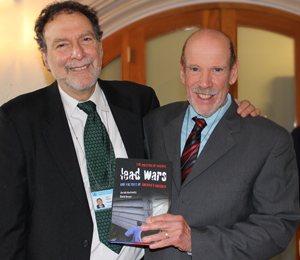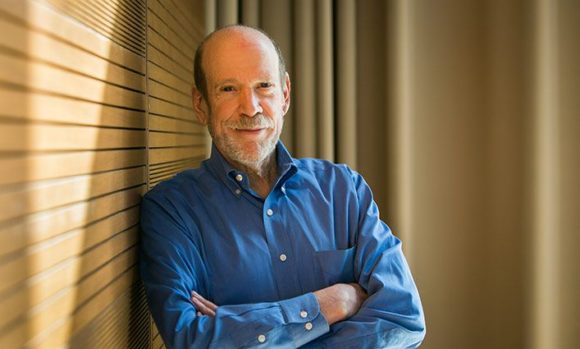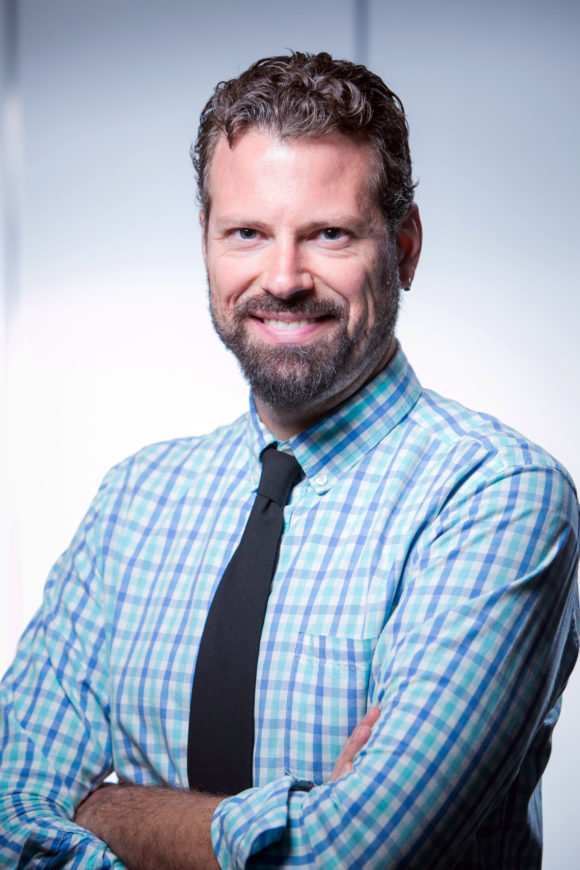Home » Posts tagged 'blog'
Tag Archives: blog
Gerald Markowitz shines light on corporate bad behavior
Distinguished Professor of History Gerald Markowitz and long-time writing partner David Rosner, a Professor of Sociomedical Sciences at Columbia University, have been researching industrial pollution and contaminants since the early 1970s. Their first jointly-authored book, Deadly Dust: Silicosis and the Politics of Occupational Disease in Twentieth-Century America, explored historical evidence of the lung disease silicosis, which is a hardening of the lungs due to inhaling dust found in sand or rock. Thanks to Deadly Dust, Markowitz and Rosner came to the attention of lawyers bringing workplace safety suits on behalf of construction workers suffering from silicosis, launching a long career of research and expert testimony on occupational disease and toxic substances. In the early 2010s, the duo began an investigation into asbestos and asbestos-related disease.
 Their work turned up hundreds of articles on the dangers of asbestos, now a watchword for poisons that can lurk in our homes, dating from 1898 to the present. Markowitz and Rosner also referred to corporate records and documents made public through court discovery; a more recent project called ToxicDocs is an open-source, online database of more than 15 million pages of documents related to silica, lead, vinyl chloride, and asbestos that were previously not easily accessible.
Their work turned up hundreds of articles on the dangers of asbestos, now a watchword for poisons that can lurk in our homes, dating from 1898 to the present. Markowitz and Rosner also referred to corporate records and documents made public through court discovery; a more recent project called ToxicDocs is an open-source, online database of more than 15 million pages of documents related to silica, lead, vinyl chloride, and asbestos that were previously not easily accessible.
In June, Markowitz’s expertise was featured prominently in the American Journal of Public Health, in an article detailing a representative episode in the history of the struggle between industry and regulators. In “Nondetected: The Politics of Measurement of Asbestos in Talc, 1971-1976,” Markowitz and his co-authors describe the years-long interval between the talc industry’s acknowledgement that asbestos is toxic and their taking action to protect consumers, and the subsequent conflict between the Conflict, Toiletry, and Fragrance Association (CTFA) and the U.S. Food and Drug Administration (FDA) over regulating appropriate methods for detecting asbestos contamination in consumer talc products and setting safety standards.
The focus of the article, said Professor Markowitz, “was that the cosmetic industry, I think very consciously, used this concept of nondetected, which we as consumers think of as ‘no asbestos in the talc,’ but nondetected could mean enough asbestos in the talc to cause disease. And that’s what the industry understood, but consumers did not.”
The CTFA’s 1970s victory in lowering detection standards and advocating for self-regulation is still bearing fruit; recent lawsuits against talcum powder manufacturers allege the household product causes cancer due to asbestos contamination. As recently as 2018, courts awarded plaintiffs record damages of close to $4.7 billion in a case against manufacturers, capturing public attention.
We sat down with Professor Markowitz to talk about his work researching industrial poisons and about corporate responsibility to the consumer in today’s world. Read on to hear from Professor Gerald Markowitz in his own words.
Why do you believe that talc product manufacturers continued to accept a lower standard for asbestos eradication despite known health dangers, not to mention the risks of litigation?
When they developed this idea, in the 1970s, their basic argument was that there should be as little federal regulation as possible. [The CTFA] was able to lobby the federal FDA that the technologies that the FDA was proposing were not able to be completely accurate, would give too many false positives, would take a long time to do, and would be costly. So they proposed their own method. And they’re able to eventually convince the FDA that it should not be federal but industry regulation.
But what they admit privately is that their method, which is not as demanding as the FDA’s proposed method, was not necessarily accurate and was not necessarily consistent. So to a certain extent, they were really able to forestall regulation by claiming that they could do as good a job [of detecting asbestos in talc products], even though they themselves admitted that they could not do as good a job. And by the very nature of their method, they were going to uncover much less asbestos than the FDA’s method was capable of uncovering.
Do you think there’s something special about the current moment that made this article of particular relevance?

I think it was the variety of ways that deregulation has had an impact on the health and welfare of people in the United States and other parts of the world. To the extent that these articles could help to call attention to that happening, they are important. The advantage of history is that we are able to really see the process unfold in a kind of detail that we don’t necessarily have in observing regulatory of anti-regulatory actions taking place at the moment we’re living in. That level of detail I think is instructive in terms of being able to understand how similar things could be happening today.
Would you like to see this history galvanize some kind of action?
The most important thing that can happen is that people really have to take politics seriously. The United States has a long history of mass movements really demanding and achieving fundamental reforms. Just going back to the 1960s, the demand for civil rights, the efforts of people to get voting rights for African Americans, that didn’t happen simply because Congress decided to pass a law; people were demanding it in mass actions. These are really instructive in terms of what can happen today, and even what is happening today.
Pieces accompanying your article in the AJPH, such as the one by former Assistant Secretary of Labor for the Occupational Safety and Health Administration David Michaels, suggest that corporate influence is getting stronger, to the detriment of consumer and public health. The current administration has loosened or degraded regulatory standards for a variety of products — should we expect more legal battles down the line?
Yes, absolutely. Since the 1970s there has been a very sustained effort by many businesses to oppose regulation, and you get the classic statement by Ronald Reagan, when he said that ‘government isn’t the solution, government is the problem.’ I think the legacy of that, of the push for deregulation as a means of stimulating the economy and freeing business to innovate and all of those kinds of ideas, I think the legacy of that is going to be a variety of problems, not only in consumer products but in environmental damage. It’s going to be for workers, for consumers, for people living in communities where toxic substances are going to be released, we’re going to be suffering those consequences, and the unfortunate thing is that it’s only going to be remedied in retrospect.
And to add one other element, we know that the burden, especially of environmental pollution, toxic waste, global warming, is going to affect poor communities and communities of color to a much great extent than richer communities. At a college emphasizing social justice, this becomes an even more vital issue.
Are there other consumer products known to include dangerous adulterants that are similarly being ‘underregulated?’
BPA [bisphenol A, a chemical used to make certain plastics since the 1960s] is one example; a lot of household cleaners and flame retardants are another one. We’ve discovered that flame retardants are extremely dangerous to people, and that people have them in their bodies. Formaldehyde is another one; there was a scandal about formaldehyde in temporary housing given to people after Katrina, that was unsafe.
There are lots of things we have clues about, but the real scandal is that chemicals are being produced and we’re using them in very large quantities, that have never been tested. And in the United States we have this philosophy, innocent until proven guilty. It’s the same philosophy with chemicals — they are innocent until proven guilty. The Europeans have a system, chemicals can’t be introduced until they’re proven safe. It’s a basic difference in philosophy that companies need to prove that something is safe before they can experiment on us and ensure it doesn’t cause cancer. But in the United States they say that if it does cause cancer, we’ll take it off the market, but that’s very difficult to prove and you’ve done the damage already.
You note in your article that talc researchers were disappointed when their work became known to the industry, but that ‘nothing was done until the results became public.’ Do you think it remains true in cases of corporate wrongdoing that nothing is done until the public finds out all the information?
In the 1970s, there was this wonderful act passed called the Freedom of Information Act (FOIA). The fundamental principle behind that was that if you shine the light of publicity and information and people have that, then they have the ability to act in their own interests. One contribution that historians can make is, using the older historical records, we can cast a light on activities and attitudes and actions that permit people to see what is going on and demand change.

Gerald Markowitz is a Distinguished Professor of History in the Interdisciplinary Studies Department at John Jay College and the Graduate Center of CUNY. His research focuses on the history of public health in the 20th century, environmental health, and occupational safety and health. He has authored a number of books, most recently Lead Wars: The Politics of Science and the Fate of America’s Children, also in cooperation with David Rosner.
Nathan Lents is sticking to the science
As an evolutionary biologist, and author of such books as Not So Different: Finding Human Nature in Animals and Human Errors: A Panorama of Our Glitches, From Pointless Bones to Broken Genes, Nathan H. Lents has joined the ranks of scientists whose work is under attack by proponents of intelligent design.
There is no coherent theory about intelligent design; according to Lents, the one commonality is that supporters “don’t buy modern evolutionary theory, or some part of modern evolutionary theory. They hold a whole variety of incompatible positions.” The views of intelligent design supporters range from believing the planet was created less than 10,000 years ago, to finding a role for God in gradual or ongoing acts of creation and evolution, to those who think God “set up” for life to evolve as it has in something Lents calls “the Perfect Pool Shot.”
Lents’s most recent book, Human Errors, came out in 2018 to great excitement from the science and reading communities. When it was published, he thought that intelligent design supporters “would just roll their eyes. I didn’t offer it as a serious critique [of intelligent design], so I didn’t think they would respond in a serious way but they absolutely did; they went on the attack.” Lents said it took him months to learn about the different types of creationists and how to respond to and refute their attacks effectively, promoting scientific thought without getting dragged into the mud.

This month, Lents and two co-authors can be found standing up for modern evolutionary theory in Science, a journal that has been at the center of important scientific discovery and thought since its founding in 1880, reviewing Darwin Devolves, a new book by biochemist Michael Behe. He is among the best-known figures in the intelligent design movement; Lents characterizes Behe as a serious man who views his own work as serious science.
“Michael Behe believes in common descent, the true age of the earth, that all living things have evolved, he believes in all of that. But the only thing that he takes issue with is the source of all this diversity in life, that then gets acted on by natural selection. He thinks that God or a supernatural force of some kind has to provide this new influx of genetic information somehow, periodically, and then evolution can play out for a while. Either it was preloaded in the ‘perfect pool shot’ or there are ‘continuing miracles of life.'”
While creationism and trying to explain science with a creationist mindset have always been with us, in the late 1990s Behe introduced a concept called “irreducible complexity,” and this notion has really taken over those who are trying to marry science and creationism. Irreducible complexity is the idea that evolution must be false because natural selection acts by propagating mutations that create advantage for the organism; however, some structures are so complex that they never could have evolved, because their individual pieces must work together to convey advantage. Behe holds that evolution could not have produced all of the interrelated structures in a complex system like, for example, the eye, because the innumerable steps and parts it takes to make up the eye (and therefore to create vision) aren’t advantageous on their own, and therefore could not have evolved without the hand of an intelligent designer.
Lents doesn’t agree with that theory. “What we do know is that these structures don’t evolve as fully-formed units. When the eye was evolving, it wasn’t like a fully-formed retina — boom — just appeared, and then a full-formed lens, that’s not how it works. The whole thing becomes gradually more complex, and then, of course, many, many steps later it looks like if you remove any one part the whole thing doesn’t work, but that’s because it’s evolving as a unit, not stepwise. It’s not like building a car. The good thing is that, if you look at the eye, we can find intermediates, not in the fossil record but in living things right now, that have an earlier version of the eye.”
In this review, Lents sticks to the science. They point to sections or examples in Darwin Devolves that fail to take into account evidence produced by testing modern evolutionary theory. Although Lents and both of his co-authors have been subject to attacks on their work by supporters of creationism, he says he’s learned his lesson about responding to attacks that are ultimately unserious or political in nature.
“I’ve come to realize, Lents says, “that in these exchanges, my real audience is not the intelligent design community. I’m writing for millions of silent readers who come into this debate innocently and earnestly when they see their children start to learn about evolution in middle school and they want to see what’s out there, they want to read for themselves. So that’s who I’m writing for, the people who are just genuinely trying to find answers about what the science really says, what evidence do we really have, that kind of stuff. So I’m not really speaking to the intelligent design community anymore, I’m just speaking to the general public, trying to correct the record on science.”
In fact, that really sums up Lents’s approach to writing more generally. He wrote his second book for the general public, “first of all to entertain, but also to help them understand how these little quirks that we have in our bodies have come to be, and how to live with them, and survive and thrive.” It’s very important to Lents to advance the idea of a scientific mindset, which he says intelligent design proponents don’t have.
“Science, at its best, comes at the evidence and tries to come up with an explanation that best fits that evidence. And even when that explanation starts to become what we call accepted science, it is still tested. But intelligent design supporters, including Michael Behe, their starting point is that they have a truth that they already believe is true, and then they try to mold an explanation for the science around that preconceived notion. So it’s backwards. And that’s why they end up with egg on their face so often, because they’ll come up with an explanation that fits the limited data that we have at one point in time, and then we just get more data and a fuller understanding and they have to keep revising their explanation. And that’s just not a good way to come up with the truth.”
Lents plans to continue writing fact-based science texts with the general public in mind, even if he does invite further criticisms from the intelligent design community or other conservative elements. He says he’s currently laying the foundation for his next book, “which is about human sexuality in the evolutionary context. If you see a pattern in my work, it’s that I’m getting more and more controversial with each book.” Lents wants to look at human sexuality as it’s connected to the greater natural world, and the ways that social constructs have shaped our expressions of sexuality. His argument? “A label-free approach to sexuality is much more in line with our natural biology. The only thing labels do is create restrictions.”

Dr. Nathan H. Lents is a Professor of Biology at John Jay College, as well as the Director of John Jay’s Honors College. Apart from being the author of the two books mentioned above, Dr. Lents blogs at The Human Evolution Blog and on Psychology Today. For more, read his bio.
To read his review with co-authors Joshua Swamidass and Richard Lenski in Science, visit the website.



Recent Comments